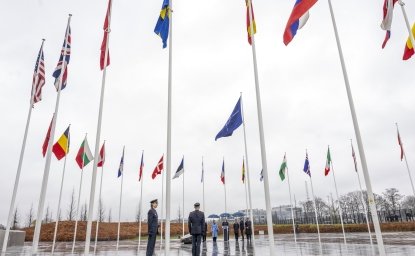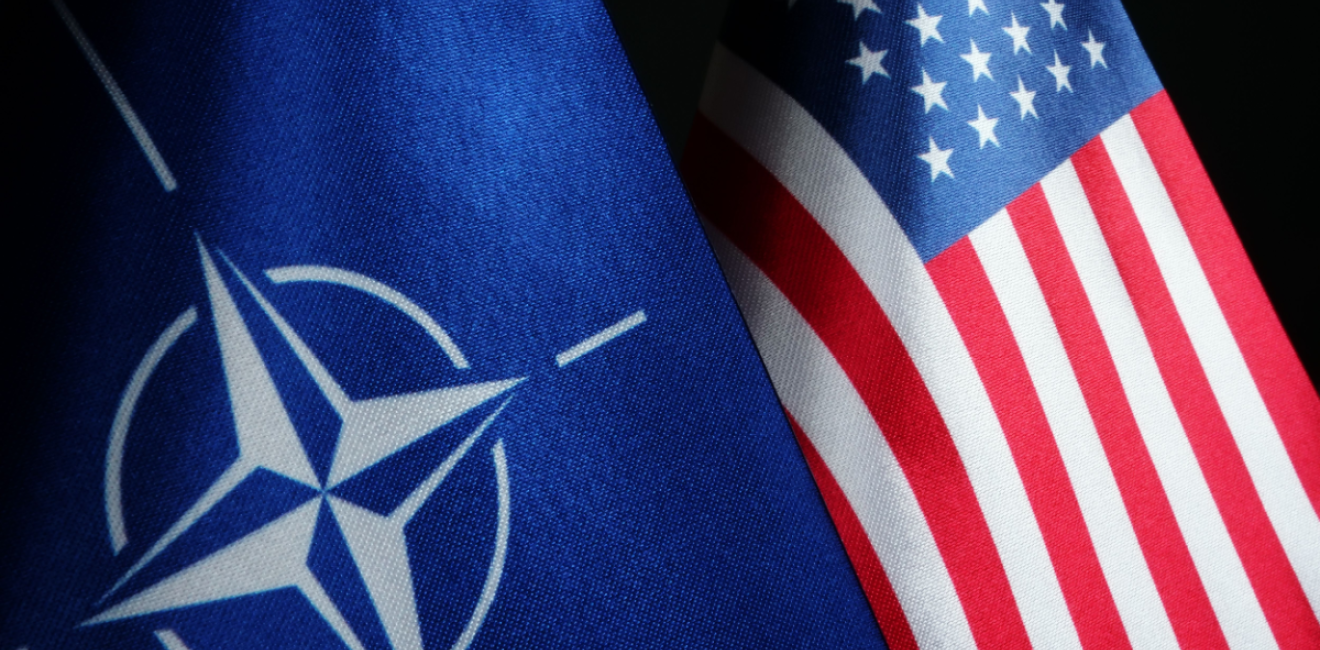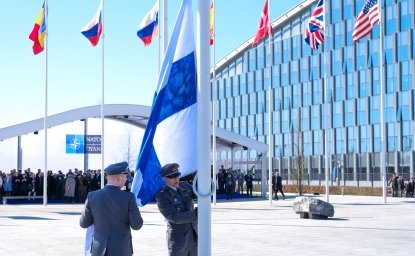For the best part of the post-World War II era the value of the North Atlantic Treaty Organization (NATO) alliance was unchallenged. Binding together Western Europe with Canada and the US as a bulwark against Soviet aggression, it was one of the twentieth century’s most readily accepted geopolitical structures.
As a military deterrent the alliance was to prove unassailable. While the Cold War was certainly a period of great tension – Budapest, Prague, Berlin and the Cuban Missile Crisis were obvious flashpoints – the threat of Soviet invasion of Western Europe, let alone North America, never seemed as imminent.
Very early on, NATO leaders realized that the benefits of the alliance extended beyond military security and included economic stability as well. In 1957, the NATO Council created an Economics Committee where the economic relationship between NATO and the East is analyzed.
As the ultimate security blanket, NATO also provided its member nations with a status as safe havens in which to invest and with which to trade. This brought broad and deep benefits to member nations, including the US.
In a November 2022 paper, University of Oklahoma economist Anthony A. Mayberry found that virtually all Eastern and Central European countries that joined NATO experienced major gains in GDP per capita as a result of their membership. Examining the three NATO enlargements that brought former Eastern Bloc countries into NATO -- 1999 (Czech Republic, Hungary, and Poland); 2004 (Bulgaria, Estonia, Latvia, Lithuania, Romania, Slovakia, and Slovenia); and 2009 (Albania and Croatia) – Mr. Mayberry found that in every case, save for that of the Czech Republic, GDP growth per capita surged after these countries joined the alliance.
He estimated that joining NATO led to average income gains per capita of roughly 15% during the first 10 years of membership. For Poland, Estonia, Latvia, Lithuania, Romania, Slovakia, and Albania the gains were between 16% -- 51% higher than would have been the case without membership. The gains for Hungary, Bulgaria, and Croatia were smaller but still significant with GDP per capita rising between 6%-9%.
In a single year, the economies of Estonia and Latvia, which both joined NATO in 2004, posted substantial increases in economic output. One year after joining the alliance, Estonia’s GDP growth leapt from 6.5% to 9.5%, while Latvian economic expansion accelerated from 8.7% to 10.6%. In Estonia, foreign investment more than tripled from $965.8 million to $3.1 billion after NATO accession.
Even before joining they join alliance, candidate countries saw huge improvements in investor confidence that led to significant gains in foreign direct investment. The stability and security of membership proved to be a major attraction for investors. Once Slovakia’s membership ticket was punched foreign investment soared by 318%, while in Slovenia investment rose 148.7%, in Romania 166.29%, Bulgaria 47.5%, Lithuania 290% and Latvia 90%.
The US has also benefitted economically from NATO expansion. Excluding East Germany, which reunified with West Germany in 1991, US exports to new NATO member countries rose from $900 million in 1989 to $9.4 billion in 2016.
A 2014 report from the Rand Corporation argues persuasively that “US security commitments have significantly positive effects on US bilateral trade.” By the same token, a reduced security presence would adversely impact US trading relationships. The study suggests that trade would fall by $450 billion were security commitments to be cut by 50%. Such a cut would in turn lead, says Rand, to a decline in GDP of “as much as $490 billion.”
The collapse of the Soviet Union and the reunification of Germany may have led some countries – including the US – to take NATO for granted. But in Europe, Russia’s invasion of Ukraine has given the alliance a prominence and importance it has not seen in decades. Moscow’s actions have sparked long neutral states Finland and Stockholm to join the NATO fold while bolstering the military commitment of those members which had been either Soviet republics or members of the Warsaw Pact.
Still, some leaders have questioned the utility of the Atlantic alliance. In 2019, French President Emmanuel Macron said NATO was poised to become “brain-dead.” As a candidate for president in 2016, Donald Trump regularly referred to NATO as “obsolete.”
Now, Mr. Macron, sings a different tune. In February he said the presence of NATO troops fighting Russians in Ukraine could not be excluded. Mr. Trump’s position, on the other hand, seems little changed.
In fact, Washington has grumbled for decades about European Allies failing to shoulder an appropriate financial and military burden to support an alliance which after all is designed to protect its very borders.
Following Russia’s occupation of Crimea in 2014, the heads of State and government of NATO’s 32 members pledged to spend at least 2% of their GDP on defense, or a total of roughly $380 billion. Such outlays would boost the alliance’s capacity to respond to any further Russian aggression and provide a stabilizing counterpoint to volatility in the Middle East.
But many NATO members have fared poorly in reaching this target. In 2023, for example, defense contributions from a majority of NATO members (18) fell short of the threshold. It is interesting but perhaps not surprising that the NATO members physically nearest to Russia consistently meet their obligations. Poland spends the highest percentage of its GDP on defense (3.9%), more even than the US (3.49%). Britain and Greece exceed the threshold as well. Countries in Eastern Europe reliably hit their targets -- Estonia (2.73%), Lithuania (2.54%), Finland (2.45%), Romania (2.44%), Hungary (2.43%) and Latvia (2.07%)
US grumbling became more ominous when Donald Trump was elected president in 2016. As president he made noises about leaving NATO but never really pushed the issue too much. But in February he told a rally in Conway, South Carolina that he would not defend those that do not meet the 2% target. “No, I would not protect you. In fact, I would encourage them (the Russians) to do whatever the hell they want. You got to pay. You got to pay your bills.” To suggest that Mr. Trump has the attention of the Europeans is to understate the case. NATO Secretary General Jens Stoltenberg said last year that in 2024 18 nations would spend 2% of GDP on defense - up from 11 in 2023 and only three in 2014.
The very real prospect of Donald Trump’s return to the White House is forcing Europe to think long and hard about its future security and how it would respond to Russian aggression. Germany has long been regarded as France’s most important European ally and its economic might is formidable. But militarily Germany is considered weak. A weakened NATO may lead France to reconsider its alliances. French officials say that should Mr. Trump win and NATO be undermined, Britain and its more formidable military prowess, would assume a more important role in French foreign policy. The importance of Britain’s military might would necessitate it having a much closer relationship between the countries with Western Europe’s strongest militaries. German officials pondered earlier this year whether they may need to obtain an independent nuclear deterrent.
A nuclear armed Germany. Soaring anxiety in Eastern and Central Europe. An emboldened Russia looking to further expand it zone of influence. Diminished confidence in the US as a dependable, reliable partner and ally. All of these scenarios are not only possible, but they are also likely should NATO weaken and fracture. Such outcomes would obviously be very bad for the economy of the US, of Europe and of the world. But given everything else that might be at stake this could be the least of our worries.
Author

Director of the Information and External Relations Division and Chief Spokesman at the World Trade Organization (retired)

Wahba Institute for Strategic Competition
The Wahba Institute for Strategic Competition works to shape conversations and inspire meaningful action to strengthen technology, trade, infrastructure, and energy as part of American economic and global leadership that benefits the nation and the world. Read more

Explore More
Browse Insights & Analysis
The Washington Summit: What's at Stake For NATO's 75th Anniversary





